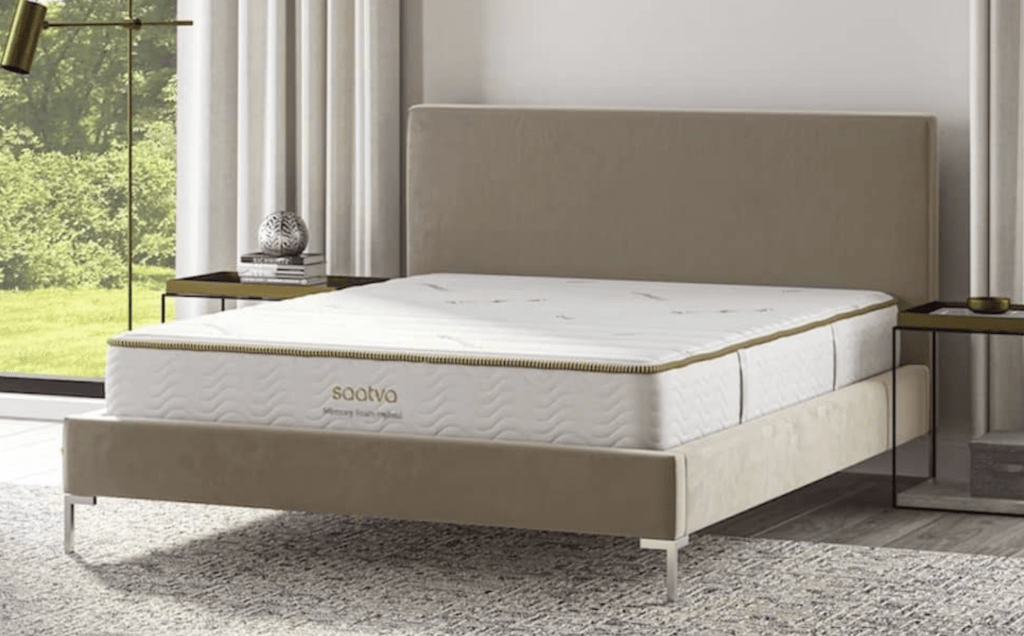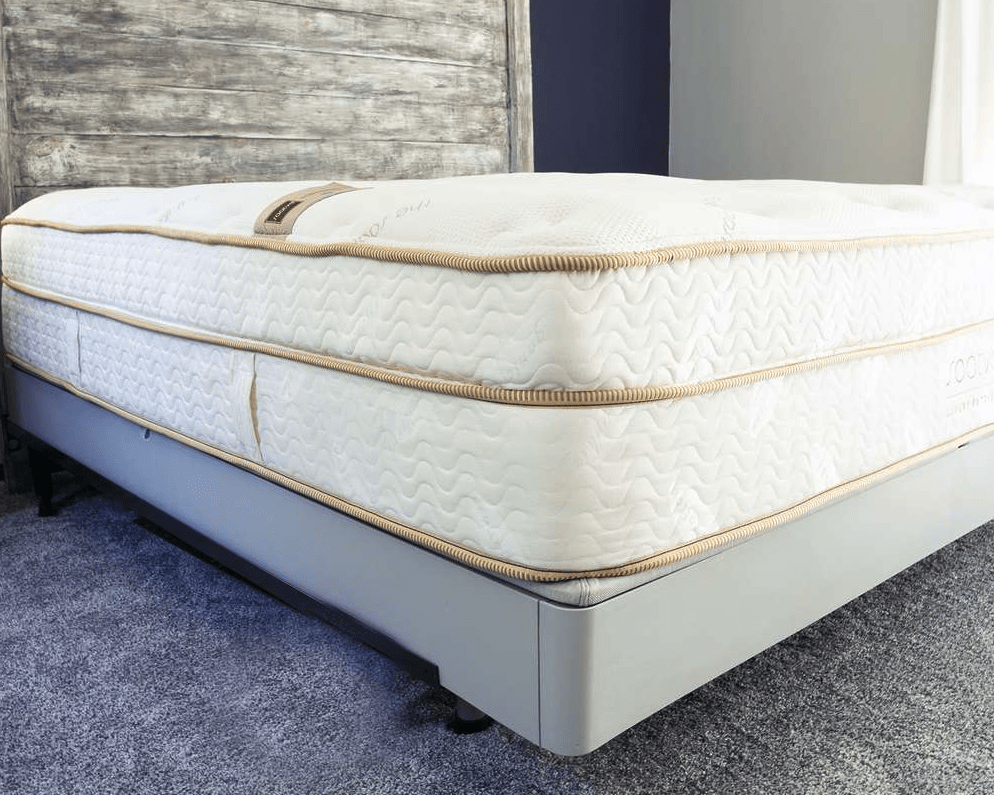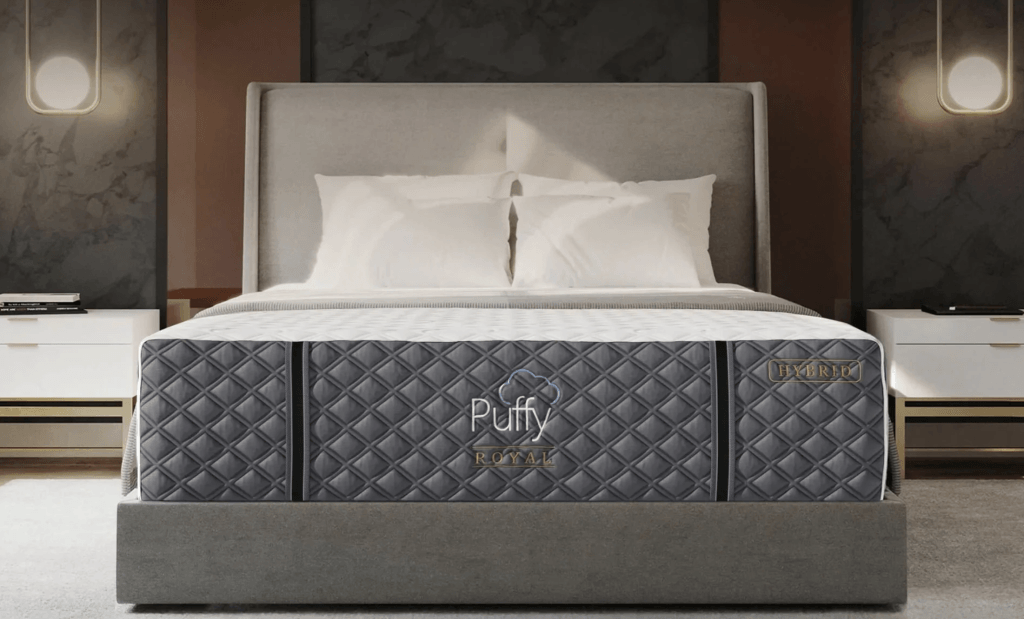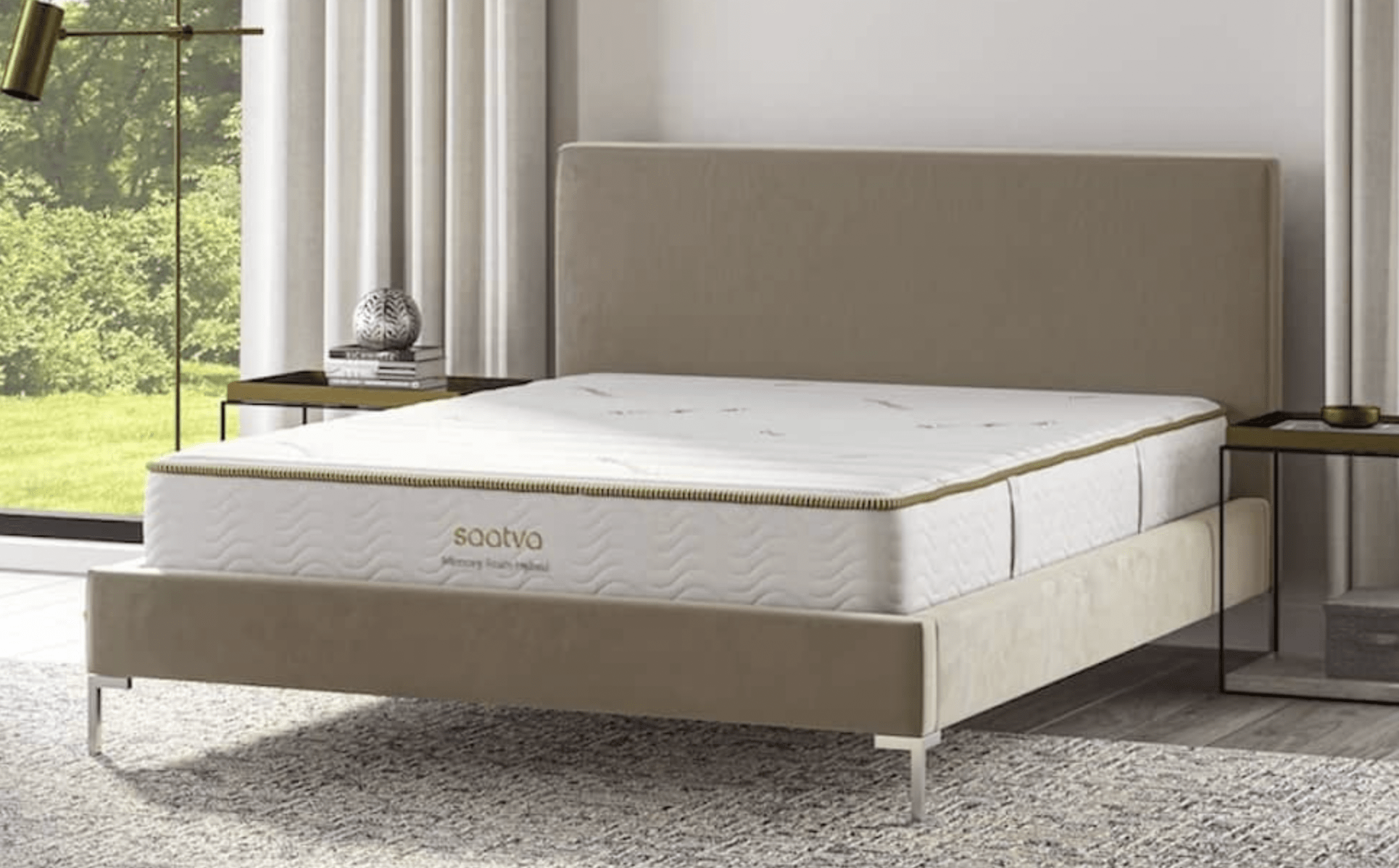Table

Saatva and Puffy, offer very different mattresses that excel in specific areas. This detailed mattress comparison for 2024 looks at all aspects of Saatva and Puffy to help you decide which is better for your sleep needs and preferences.
Saatva vs Puffy Key Differences
As a luxury hybrid innerspring, the Saatva mattress provides advanced support and cooling from its dual coil system. With three firmness levels to choose from, Saatva works for all sleeping positions. Meanwhile, the Puffy is an all-foam mattress incorporating cooling and pressure relieving foams for a medium firm, hugging feel. Puffy only comes in one comfort option.
In terms of price, Saatva ranges from $1,195 to $2,095 for a Queen while Puffy costs $1,249. Saatva has more bounce, better edge support, and superior cooling. Puffy beats out Saatva in motion isolation and sinking, body-contouring comfort. Read on for full details on performance, construction, policies, and more.
Saatva Mattress Overview

Mattress Type: Hybrid innerspring
Height: 11.5″ or 14.5″
Firmness: Plush Soft (3-4), Luxury Firm (5-7), Firm (7-8)
Trial Period: 180 nights
The Saatva is a premium hybrid innerspring with advanced features and a refined design. It comes in three firmness levels and two heights to suit the widest range of sleepers.
The comfort system uses responsive memory foam and polyfoam layers. Underneath lies the support core with Saatva’s unique dual coil system. An upper layer of pocketed microcoils contours closely to the body while a base layer of heavier Bonnell coils prevents sagging. Other high-end details include an organic cotton cover and antimicrobial treatment.
With its responsive surface and stable support system, the Saatva rates well for sex, edge support, and ease of movement. The multiple firmness options ensure most sleepers can find a suitable comfort level regardless of sleeping position. Plus, the coil construction promotes steady airflow to help hot sleepers stay cool.
Puffy Mattress Overview

Mattress Type: Memory foam
Height: 10″
Firmness: Medium Firm (6)
Trial Period: 101 nights
Puffy makes just one all-foam mattress offered at a universal medium firm to appeal to the widest range of sleepers. Its three foam layers are designed to contour gently for pressure relief while also sleeping cool.
The top comfort layer consists of Puffy’s Cooling Cloud foam. This proprietary foam incorporates temperature regulating gel beads. Next, the Climate Comfort foam acts as a transitional layer before the high-density base foam. The mattress has a soft, stretch knit cover that is removable and washable.
With its medium firm feel, the Puffy cradles the body to alleviate tension in the shoulders, hips, and back. It isolates motion well for undisturbed sleep when sharing the bed. And the foam construction allows for silent operation. The Puffy lacks bounce and edge support, which is typical for an all-foam mattress.
Comparing Construction
The Saatva and Puffy mattresses differ quite a bit in their construction and materials. As a hybrid, the Saatva pairs foam comfort layers with a dual coil support core. The Puffy is made entirely of foam.
Cover
- Saatva: organic cotton cover
- Puffy: soft and stretchy polyester blend
Comfort Layers
- Saatva
- Memory foam lumbar pad
- Polyfoam comfort layer
- Memory foam comfort layer
- Quilted foam
- Puffy
- Cooling Cloud foam
- Climate Comfort foam
Transitional Layer
- Saatva: Pocketed microcoils (1,000+)
- Puffy: None
Support Core
- Saatva: Bonnell coils (416)
- Puffy: High-density polyfoam
These differences directly impact performance factors like pressure relief, temperature regulation, and ease of movement. The Saatva’s hybrid design lends itself better to cooling, bounce, and edge support while the Puffy’s all-foam construction isolates motion extremely well.
Comparing Firmness and Feel
When it comes to firmness and feel, significant differences arise between these two mattresses. As a hybrid, the Saatva has more bounce and responsiveness. And offering three firmness levels allows customers to really customize the mattress’s feel. The all-foam Puffy has deeper contouring to cradle the body.
Saatva Firmness and Feel
- Plush Soft (3-4): Extra cushioning but with support for side sleepers
- Luxury Firm (5-7): Balanced comfort suitable for most people
- Firm (7-8): Very supportive for back and stomach sleepers
With its hybrid design, the Saatva has notable bounce and responsiveness. The coil system gives it pushback when you move or change positions. Combining foam and coils also prevents you from feeling stuck in the bed.
The three firmness options ensure most sleepers can find a suitable comfort level. Side sleepers tend to prefer softer versions for pressure relief while back and stomach sleepers need firmer options to keep the spine aligned.
Puffy Firmness and Feel
- Medium Firm (6): Conforming cushion for side sleepers
The Puffy has a soft, hugging feel without allowing you to sink too deeply. This makes it best suited to average weight side sleepers who need cushioning around the shoulders and hips.
As an all-foam mattress, the Puffy allows for close conforming and motion isolation. You don’t get that bouncy, responsive surface found on the Saatva. There is some light cradling from the memory foam comfort layers.
Comparing Sizing and Pricing
The Saatva and Puffy mattresses come in all six standard mattress sizes. Customers can choose between 11.5” or 14.5” profile options for the Saatva while the Puffy is 10” thick. Pricing differs quite a bit between these two beds.
Saatva Mattress
Saatva mattress price list
Puffy Mattress
Puffy mattress price list
Queen sizes start at $1,195 for the Saatva while the Puffy Queen costs $1,249. Given these prices and model differences, the Saatva suits shoppers wanting a luxury hybrid with customization. The Puffy appeals to budget shoppers seeking an affordable memory foam model.
Comparing Temperature Regulation
Temperature regulation plays a key role in sleep quality and comfort. Excess heat can lead to tossing and turning while a cooler sleep environment allows for deeper, more restorative rest. The Saatva does a superior job at maintaining a neutral temperature compared to the all-foam Puffy.
Saatva
- Breathable organic cotton cover
- Coil system permits airflow
- Available with a cooling antimicrobial cover
The Saatva’s hybrid design with substantial airflow allows it to sleep cooler than most beds. Air circulates through the coil system while heat disperses across the large surface area. Using breathable, organic materials also aids temperature regulation.
Puffy
- Gel infusion in the top foam layer
- Lacks airflow of hybrid models
Like all foam beds, the Puffy is prone to heat retention. Its foam layers conform closely and can restrict airflow. However, Puffy does incorporate cooling technologies like gel and phase change materials to absorb and dissipate heat. This makes it about average for an all-foam mattress.
For those who tend to sleep hot, the Saatva is the better choice. Its coil support core permits steady airflow while materials like organic cotton and wool also wick moisture. The Puffy still sleeps reasonably cool thanks to its cooling foam, but can retain more heat.
Comparing Motion Isolation
For couples and co-sleepers, a mattress’s motion isolation determines how well you can sleep undisturbed when a partner moves. Beds that effectively reduce motion transfer allow you to stay asleep even as your partner gets up. Memory foam beds tend to excel here while coils permit more motion transfer.
Saatva
- Moderate motion isolation
- Some transfer is felt across the coils
- Foam layers absorb a portion of movement
As a hybrid, the Saatva allows for more motion transfer than an all-foam bed like the Puffy. Movement travels across the coil system to a degree so you are likely to feel your partner changing positions or getting in and out of bed. The foam layers help minimize this disturbance.
Puffy
- Superior motion isolation
- Little to no motion transfer
- Close conforming foam absorbs movement
With its all-foam construction, the Puffy cuts down on motion transfer exceptionally well. Foam naturally isolates movement as it responds slowly to pressure. Rather than transferring across the surface, motion gets absorbed by the foam so you barely feel it. This makes the Puffy ideal for co-sleepers.
For those needing minimal sleep disturbances, the Puffy is undoubtedly better in this category. Light sleepers and those sharing the bed will experience less nighttime disruptions. Couples can also engage in amorous activity without disturbing their partner.
Comparing Edge Support
A mattress’s edge support determines how sturdy and supportive the perimeter feels. Beds with reinforced edges allow you to sleep all the way to the edge or sit on the side without compression. Strong edges also give a larger sleep surface. Hybrids tend to excel here.
Saatva
- Excellent edge support
- Sturdy coil perimeter reinforced with foam
- Consistent sleep surface from edge to edge
Thanks to its durable coils, the Saatva prevents sagging or sinkage around the edges. The perimeter has added internal edge support plus high-density foam to bolster the ends. This gives the Saatva a very solid, supportive feel whether sleeping near the sides or sitting along the edge.
Puffy
- Minimal edge support
- Significant sinkage and compression
- Sleep surface feels smaller
The Puffy’s all-foam construction leaves its edges vulnerable to sinkage and feeling unstable. Without reinforced edges, the sides compress easily under body weight. This can make it difficult to use the entire sleep surface and lead to feelings of “rolling off” for those who sleep near the edge.
For those wanting to maximize their sleep space, the Saatva is easily superior in terms of edge support. Its resilient spring system and added reinforcements prevent sagging along the perimeter. The Puffy’s edges compress significantly under weight.
Comparing Durability and Warranty
The lifespan of your mattress determines how soon you need to replace it. More durable materials increase how long a bed will maintain even support and comfort. Each company offers reassurance through warranties.
Saatva
- Expected lifespan of at least 10 years
- Constructed from quality materials
- 15-year non-prorated warranty
With its sturdy coil base and reinforced edges, the Saatva rates very well on durability. Its high-grade steel coils are made to resist sagging and indentations even after years of regular use. Saatva will repair or replace any qualifying defect during the 15-year warranty period.
Puffy
- Expected lifespan of 6 to 8 years
- Higher than average foam density
- Lifetime warranty
Like other all-foam beds, the Puffy is likely to last 6 to 8 years with proper care. Its higher density foams are more durable than cheaper imports. Puffy offers strong protection through their lifetime warranty against qualifying defects.
Considering materials and construction, the Saatva should outlast the Puffy by a few years at least. However, Puffy offers a longer warranty for added consumer protection. For budget shoppers, going with Puffy means less financial risk.
Best Applications
Deciding between the Saatva vs Puffy comes down to your sleep style, priorities, and budget. Side sleepers need pressure relief while couples want motion isolation. Hot sleepers need cooling technologies. Understanding your needs helps determine which mattress is the better choice.
The Saatva is best for:
- Shoppers wanting a luxury hybrid
- Those who prefer bounce and responsiveness
- Sleepers needing strong edge support
- Couples wanting ease of movement
- Hot sleepers needing steady airflow
- Eco-conscious buyers (organic materials)
With its high-end hybrid design and reinforced edges, the Saatva suits shoppers wanting that luxury hotel feel. It works for combination sleepers who change positions thanks to ease of movement. Hot sleepers can rest easy on this breathable, cool-sleeping mattress.
The Puffy is best for:
- Side sleepers needing pressure relief
- Couples requiring motion isolation
- Petite to average weight people
- Those wanting full-body contouring
- Budget shoppers seeking value
The Puffy cradles side sleepers to alleviate tension at the shoulders and hips. Its superior motion isolation makes it ideal for co-sleepers. The medium firm feel suits petite to average weight individuals. And the close conforming foam comforts strict side sleepers.
Mattress Buzz is reader supported. When you buy a product through our links we may earn an affiliate commission.

